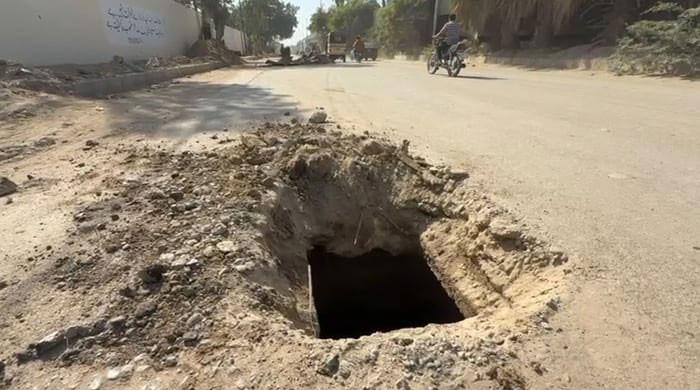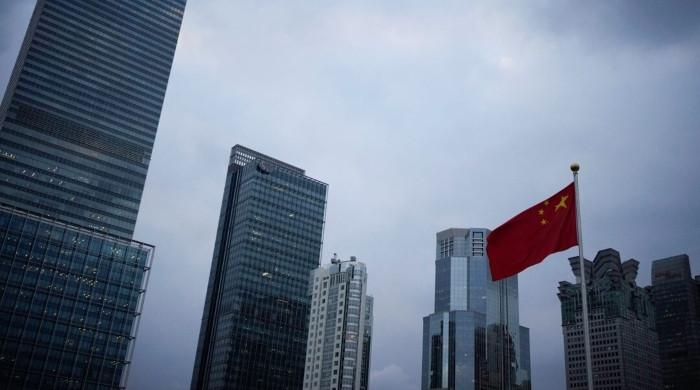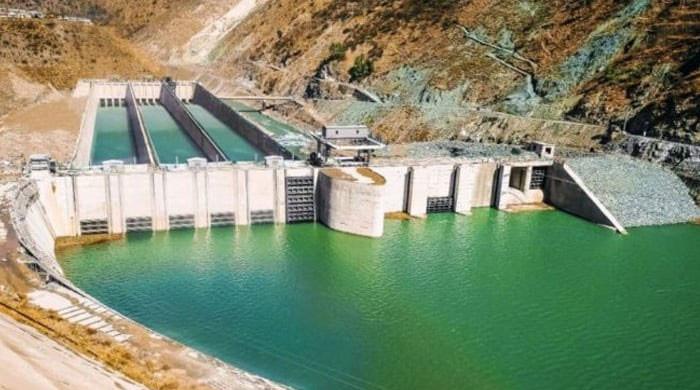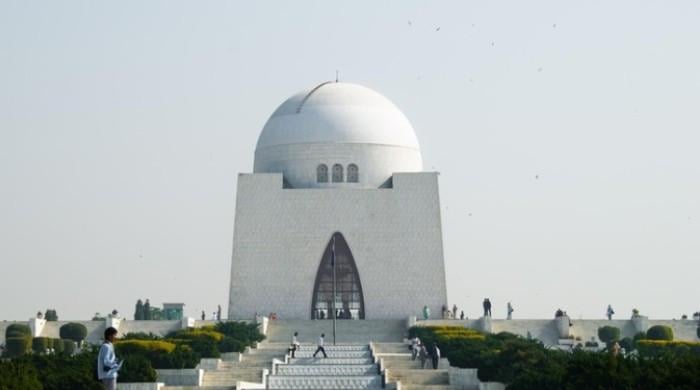The atomic model of success
Today, our youth can give Pakistan prosperity through the formula given by scientists in 1998
October 23, 2025

On May 28, 1998, Pakistan did what the world thought was impossible. In the barren mountains of Chagai, we entered the elite nuclear club. It was not just a scientific achievement but a triumph of will, discipline, and national purpose.
Soon after those historic nuclear tests, I had the privilege of meeting two of Pakistan's great scientific leaders – Dr Abdul Qadeer Khan (Kahuta) and Dr Ishfaq Ahmad Kahuta (PAEC). I asked them a question that had long been on my mind: What was the secret recipe that enabled Pakistan to achieve what the world's most powerful nations tried to prevent?
We had faced sanctions, technology denials, and severe resource constraints. The global order was stacked against us. Yet, we succeeded while in many other areas, where the world is willing to help us and resources are available, we continue to struggle. Why? Their answer has stayed with me to this day. They said that Pakistan's nuclear achievement was not an accident. It was the result of a management philosophy – a culture of excellence, merit, discipline, and shared national purpose.
That system, if applied elsewhere, could transform Pakistan once again. It is our own indigenous model of success. I call it 'The Atomic Model of Success'. This model is timeless. It is Pakistan's own blueprint for achieving the impossible, a model that can guide our next great national mission, 'URAAN Pakistan': transforming Pakistan into a trillion-dollar economy and a globally competitive nation by 2035.
The salient features of the Atomic Model of Success, narrated by them, are as follows: one, the nuclear programme was not built on machines or money but on a shared vision and mission. From the janitor to the top scientist, everyone in Kahuta and the PAEC had one common purpose: to make Pakistan's defence invincible, strong, and self-reliant. Every member of the organisation took ownership of the vision.
This unity of purpose turned ordinary individuals into extraordinary achievers and produced an ecosystem that nurtured the collective competence of the organisation. Today, Pakistan needs to rediscover that same sense of collective purpose – but this time, for economic strength. Our new national mission, 'URAAN Pakistan' which aims to make Pakistan a trillion-dollar, knowledge-driven economy by 2035, should be every Pakistani's vision and mission. Every government department, every entrepreneur, every youth, and every policymaker must internalise this purpose: to make Pakistan strong through economic transformation.
The atomic programme succeeded because every person knew exactly why their work mattered. We need to build that same clarity of 'why' into our national development – a sense that every reform, every innovation, and every policy is part of a grand national purpose.
Two, stability of leadership. Each chairman of our nuclear institutions served for at least six years. That stability of tenures provided continuity, consistency, trust, and long-term vision. Dr AQ Khan remarked, “If our chairmen had been coming and going like prime ministers, we would have been making fireworks instead of delivering the nuclear bomb". This observation carries a profound lesson for our governance system.
In successful countries, leadership stability is seen as an asset – allowing institutions to mature and deliver over time. Whether it was Malaysia's industrial transformation under Mahathir Mohamad, China's emergence as an economic superpower, or Singapore's rise under Lee Kuan Yew or South Korea's decades-long industrial policies, stability enabled results.
Pakistan's national institutions must be insulated from political turbulence. If we can provide continuity of leadership in key ministries, corporations, and development programmes for at least five to seven years, we can replicate the same performance consistency that made the atomic program succeed.
Three, the atomic programme operated on a single principle: no sifarish, only merit. Recruitment, promotions, and assignments were strictly performance-based. Every scientist knew that excellence was the only currency of progress. It was this culture that enabled Pakistan to compete with technologically advanced countries despite having fewer resources.
Unfortunately, much of our public sector today suffers from the opposite: patronage, favouritism, and political appointments. If we want to see Pakistan transform, meritocracy must become our national creed – from classrooms to boardrooms, from civil service to state enterprises.
No nation has ever risen without putting its best minds at the helm of its toughest challenges. South Korea's transformation from a poor agrarian society to a global tech powerhouse was driven by its meritocratic bureaucracy. China's rapid industrial growth was powered by merit-based selection in key institutions. Pakistan's atomic model proves we already have that capability – we just need to institutionalise it across all sectors.
Four, investment in human resources. The success of the atomic programme was not built on machines and technology, but on people – scientists, engineers, and technicians who were empowered and trained to perform miracles. Both KRL and PAEC invested heavily in human development – training abroad, knowledge exchange, and internal R&D culture. Machines were just tools; the real power lay in human intellect and brainpower.
Today, Pakistan's future depends on how effectively we invest in our youth capital. Our 240 million citizens, two-thirds of whom are under 30, are our real atomic energy. If equipped with skills, creativity, and digital literacy, they can fuel Pakistan's next economic revolution.
The government's current focus on digital skills, vocational training, and innovation ecosystems is rooted in this understanding. We have to build a knowledge-based economy where ideas and talent are the main drivers of value, not just natural resources. Just as our scientists mastered nuclear technology without external help, our youth can master artificial intelligence, robotics, and renewable energy if given the right environment and belief.
Five, provision of adequate resources. Even during economic hardship, the state ensured that the nuclear programme never ran short of the resources it needed. That decision reflected national priorities. We cannot build excellence on leftover budgets. Similarly, if we want our institutions to deliver excellence in education, science, technology, and public service, they must be funded adequately. When we underinvest in our schools and research centres, we compromise our future security more than any external threat ever could.
Pakistan spends less than 2% of its GDP on education and research combined. If we want to create an 'economic Chagai', this must change. Just as the atomic programme was funded with conviction, our human development must now be funded with the same seriousness. Budgets are the truest expression of priorities. We cannot talk about transformation and continue to allocate minimal resources to the very sectors that build national capacity.
Six, perhaps the most critical factor behind the atomic success was functional autonomy. The organisations had clear mandates and the freedom to execute them. They did not operate under daily bureaucratic interference. Their leadership was trusted, and that trust unleashed creativity, problem-solving, and innovation. Today, much of our public sector is paralysed by red tape, overlapping jurisdictions, and fear of accountability. The result: slow decision-making and missed opportunities.
If we want high performance, we must give our institutions the freedom to act, coupled with transparency and accountability. The world's most successful institutions, from NASA to the Chinese Academy of Sciences, show how autonomy with accountability can achieve miracles. Pakistan's nuclear institutions proved it decades ago. The same principle must now guide our economic, planning, and scientific institutions.
The Atomic Model of Success is more than a management philosophy; it is a story of national belief. It shows that even under isolation, a committed nation can achieve what others call impossible. In 1998, sanctions isolated Pakistan from the world. Yet, from isolation, we found innovation. Today, we face no sanctions, but we still struggle with stagnation. The challenge is not capability but coordination, continuity and culture.
The atomic model teaches us that success is about systems – systems that reward excellence, not connections. Systems that give stability, not uncertainty. Systems that align effort with purpose. If we can replicate this model in our governance and economy, Pakistan can achieve another miracle – this time, turning its economic potential into performance under 'URAAN Pakistan'.
Every generation is given one defining mission. For the generation of 1998, it was to secure Pakistan's defence. For the generation of today, it is to secure Pakistan's economic future. Let us convert the unity of Chagai into the discipline of our markets, the innovation of our labs, and the excellence of our classrooms. Let us transform the 'nuclear spirit' of national pride into a 'development spirit' of collective progress for another mission – Maarka-e-Taraqi.
The scientists of 1998 gave us invincibility through knowledge and resolve. Today, our youth can give Pakistan prosperity through the same formula. The time has come to apply that same Atomic Model of Success – not to build weapons, but to build wealth, well-being, and a winning nation.
The writer is the federal minister for planning, development, and special initiatives. He tweets/posts @betterpakistan and can be reached at: [email protected]
Disclaimer: The viewpoints expressed in this piece are the writer's own and don't necessarily reflect Geo.tv's editorial policy.
Originally published in The News









